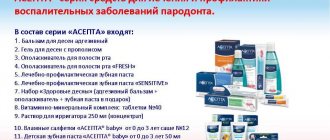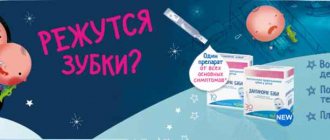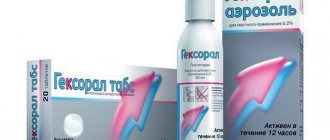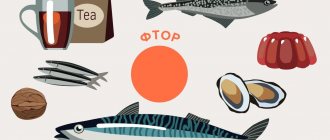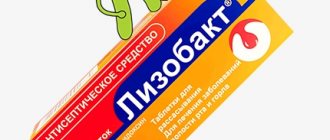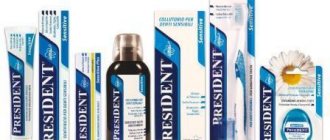Gum inflammation is accompanied by a number of painful symptoms that not only affect your well-being, but also affect your ability to chew and speak normally. To eliminate unpleasant signs in dentistry, special gels are used. They act directly on the oral mucosa and are slightly absorbed into the blood, which makes them safe for children.
Painkillers and anti-inflammatory gels can be used during teething (Baby Doctor) and for complex treatment of gingivitis or stomatitis.
Pharmacology and pharmacodynamics
The gel helps fight inflammation, relieves pain and has an antimicrobial effect.
The active substance perfectly anesthetizes the area to which the gel was applied and eliminates inflammation. The analgesic effect lasts for 3-8 hours. Another active component has an antiseptic effect, killing harmful microorganisms.
The medicine has a certain structure, due to which it penetrates well into the tissue and remains on the oral mucosa for several hours. Almost does not enter the blood circulation.
Holisal or Metrogyl Denta: which is better?
Metrogyl denta contains the antiseptic chlorhexidine 0.05% and the antibiotic metronidazole 1.0%.
This is the very first drug for the treatment of gum inflammation, which appeared in our country about 30 years ago. Its cheaper complete analogues are the drugs Dentamet gel and ASEPTA gum balm. Both components of the drug (chlorhexidine and metronidazole) have only an antimicrobial effect and do not have a direct anti-inflammatory effect. Dental gel “MetrogilDenta” –
The concentration of chlorhexidine in MetrogylDenta is very low, and it is more suitable - either for children and adolescents, or for the treatment of gingivitis in adults. The latter is due to the fact that for the treatment of periodontitis in adults, higher concentrations of chlorhexidine will be optimal - in gels for gums it should already be from 0.2 to 0.5%. Although, on the other hand, you can compensate for the lack of chlorhexidine concentration in MetrogilDenta by preliminary antiseptic rinsing with a 0.2% chlorhexidine solution, after which you can apply the gel.
But in fact, such a combination makes little practical sense, because 0.2% chlorhexidine already has a pronounced antiseptic (antimicrobial) effect. In addition, all the components of MetrogilDent also have only an antimicrobial effect, and it turns out that when prescribing these drugs, we do not use anti-inflammatory components at all. In addition, local use of antibiotics in the oral cavity is undesirable and even harmful, because this leads to the formation of resistant strains of bacteria, which become even more pathogenic to the gums.
Therefore, the optimal combination for treating gums is an antiseptic mouth rinse with 0.2% chlorhexidine and Cholisal dental gel, because the latter has not only an antimicrobial, but also an anti-inflammatory effect due to the content of choline salicylate. I hope that our answer to the question: Which is better, Cholisal or Metrogyl Denta, was clear to you.
When to use
The gel is prescribed in the following cases:
- stomatitis;
- cheilitis;
- damage to the integrity of the mucosa due to the use of prostheses or as a result of mechanical impact;
- pain relief after dental surgery;
- when teething in babies;
- other damage and inflammatory processes in the oral mucosa.
Cholisal gum gel: indications for use
First of all, we will be interested in the usual Cholisal-gel, because... This is what we will use in courses of anti-inflammatory therapy for gum inflammation (gingivitis and periodontitis). This drug has a truly powerful anti-inflammatory effect, and this is what will be discussed in our article. This medication may be used in the following situations:
- in the treatment of gingivitis,
- in the treatment of periodontitis,
- with inflammation of the hood above the wisdom tooth,
- with inflammation of the mucous membrane under removable dentures,
- with stomatitis,
- during teething in children,
- for injuries to the mucous membrane (including when wearing braces).
Indications for Cholisal DENTAL gel –
Gel Cholisal Dental can be used only in the intervals between courses of anti-inflammatory therapy with Cholisal gel (as maintenance therapy). This gel has good antioxidant properties, which will not help us in any way in the treatment of acute or chronic gum inflammation.
Adverse reactions and overdose
In rare cases, side effects may occur. A tingling or burning sensation may be felt at the sites where the ointment is applied. This reaction usually disappears after a few minutes. Various allergies may also appear.
No cases of overdose have been identified to date. The gel does not need to be swallowed, only used topically. If there is a lot of ointment on the mucous membrane, then you need to rinse your mouth well. If the composition gets into the gastrointestinal tract, you need to rinse the stomach. Treatment is carried out taking into account the existing symptoms.
Popular dental gels for teething
At the moment, gels for teeth and gums are presented by many companies. To make your choice easier, let's look at the most popular ones.
Dentinox
It is a transparent gel with a yellow tint and a distinct scent of mint and chamomile. Using Dentinox gel for preventive purposes allows you to achieve painless and normal formation of the first incisors, primary and subsequent molars. This drug also prevents inflammation of the oral mucosa (stomatitis), irritation of the gums and any painful sensations.
- Composition 1 g of the drug . Active ingredients - tincture based on chamomile flowers (150 mg), polidocanol 600 (3.2 mg), lidocaine hydrochloride (3.4 mg); excipients - xylitol, carbomer (974 P), sorbitol, propylene glycol, polysorbate 20, levomenthol, purified water, sodium edetate, saccharin and hydroxide.
- Side effects . The appearance of a slight burning sensation, redness and irritation. In some cases, allergies may develop, including contact allergic reactions, itching, skin rashes and angioedema. If any of the side effects occur, stop using the product and consult a doctor.
- Contraindications . Hypersensitivity to the substances of the drug, the presence of open wounds on the mucous membrane in the oral cavity. Due to the sorbitol content, Dentinox is not recommended for the treatment of children with congenital fructose hypersensitivity.
Cholisal-Gel
Compared to cooling gels based on lidocaine, Cholisal has a pathogenetic effect aimed at getting rid of the cause of pain in this process - swelling and inflammation.
After application to the surface of the gums, the active substance of the drug, choline salicylate, is absorbed by the mucous membrane and relieves local inflammation: compression and swelling of nearby tissues are reduced, due to which the pain effect disappears. The adhesive base of the gel ensures a rapid onset of the effect (after 2-3 minutes), as well as its long-term retention, which allows Cholisal to eliminate unpleasant sensations during teething in children for up to 8 hours in one application.
- Composition per 1 g of product . Cetalkonium chloride (100 mcg), choline salicylate (87.1 mcg); auxiliary components - anise seed oil (1.61 mg), methyl parahydroxybenzoate (1.5 mg), ethanol 96% (390 mg), hyaetellose (20 mg), glycerol (50 mg), propyl parahydroxybenzoate (0.8 mg), water (up to 1000 mg).
- Side effects . Allergy; A short-term burning sensation may occur in the area of application of the product, which can be eliminated independently.
- Contraindications . Hypersensitivity to salicylates, as well as other components of Cholisal. When treating a child under 1 year of age, caution should be exercised.
Kalgel
Designed to eliminate pain during teething in children aged 5 months and older. Calgelalidocaine, which is part of the product, helps block the excitability of the membranes of the most sensitive nerve endings, and cetylpyridinium chloride is responsible for suppressing harmful microorganisms.
- Compound . Cetylpyridinium chloride (10 mg), lidocaine hydrochloride (33 mg); auxiliary components - xylitol, sorbitol solution 70%, glycerin, PEG-40 castor oil, ethanol 96%, xylitol, hydroxyethylcellulose 5000, laureth-9, sodium saccharin, hydrogenated concentrate, macrogol 300, vegetable flavor, levomenthol, caramel E150, purified water .
- Side effects . Allergy, as well as local irritant effect with prolonged use.
- Contraindications . The presence of hypersensitivity to the main and auxiliary substances of the drug, liver or kidney failure, bradycardia, heart failure of the II or III degree, arterial hypotension, intraventricular conduction disturbance.
Pansoral “First teeth”
The most popular herbal gels to ease teething without anesthetics. At the same time, the plant extracts included in the composition have a softening and soothing effect on the gum mucosa.
- Compound . Extracts of marshmallow root (49.75 mg), saffron flowers (1 mg) and Roman chamomile (49.75 mg); excipients: sodium methylparaben, glycerol, sodium propylparaben, purified water, sodium saccharin, carbomer, sodium benzoate, Irish moss and triethanolamine.
- Side effects. Not identified.
- Contraindications . Newborns up to 4 months, hypersensitivity to the components of the drug.
Kamistad
Refers to the number of dental gels for small children, used at 3 months and later. Kamistad has a quick pain-relieving effect and allows you to temporarily normalize the child’s general well-being. Due to the high content of lidocaine, treatment of children under 12 years of age should be carried out only as prescribed by a pediatrician.
- Compound . Active ingredients: tincture of chamomile flowers (protects against inflammation), lidocaine hydrochloride (anesthetic for pain relief); excipients: purified water, sodium saccharin dihydrate, benzalkonium chloride, trometamol, carbomers.
- Side effects . If you follow the recommended dosage of the gel, there are no side effects. In rare cases, a burning sensation may occur in the area where the gel is applied, as well as transient hyperemia.
- Contraindications . Hypersensitivity. Not recommended for treating infants under 3 months.
Dentol
Indicated for quick relief of pain in children from 4 months during teething. After application, Dentol begins to act after 1 minute and provides an analgesic effect for 20 minutes.
- Gel composition .7.5%: per 1 g: benzocaine (75 mg); excipients - sodium saccharin, polyethylene glycol 8 and 75, glycerin, red dye, cherry flavor, ascorbic acid, purified water.
- Side effects . If the dosage is observed, no negative effects have been identified. There is a possibility of side effects due to individual intolerance. If swelling, itching, or hyperemia occurs in the area where the drug is applied, its further use should be discontinued.
- Contraindications . The presence of infection or multiple wounds at the site of application of the gel. Hypersensitivity to benzocaine.
Baby Doctor "First Teeth"
The product has a pinkish tint and is odorless and tasteless. Instantly eliminates inflammation and soothes gums. Regular use can significantly facilitate the process of teething without any complications, making it recommended for infants and older children.
- Compound . Calendula (5.8%), chamomile (5%), water (70%), echinacea (5%), methylparaben (0.2%), marshmallow root (5%), plantain (5%), methylcellulose (4 %).
- Side effects . When using the drug in recommended doses and according to indications, there are no side effects.
- Contraindications . Hypersensitivity to herbal components of the medicinal product.
Reviews
Regarding the use of the gel during teething, you can find mostly positive reviews. The drug quickly and effectively copes with inflammatory processes, relieves pain and cools the affected area. If you use the product the night before going to bed, its effect will last almost until the morning. It also has an antipyretic effect. For many, it is a plus that the composition does not contain lidocaine, since it can provoke various and severe allergies.
There are also many positive reviews when using ointment for stomatitis. Within 3-5 minutes you can notice a significant improvement in your condition, pain and discomfort disappear. Inflammation disappears 15-20 minutes after application. If you apply compresses before going to bed, you can quickly get rid of the problem and its symptoms.
Holisal Dental or Holisal: which is better?
To the question: which is better than Holisal DENTAL or CHOLISAL - we have already answered at the beginning of this article.
Let us repeat that Cholisal DENTAL gel is not intended for the treatment of acute or chronic inflammation of the gums, nor for the treatment of stomatitis, nor for anesthesia of the mucous membrane. This drug has only antioxidant properties (i.e., it reduces vascular permeability, thereby reducing swelling and bleeding of the gums, and can also increase local immunity of the oral mucosa). Composition of the gel Cholisal DENTAL –
Therefore, CHOLISAL gum gel is certainly stronger and more effective. As for the drug Cholisal DENTAL (instructions), it is no longer registered as a medicine. But you can use it to prevent exacerbation of gingivitis or periodontitis - between periodic courses of using regular Cholisal gel (so to speak - as maintenance therapy). Application regimen: 2-4 times a day, immediately after oral hygiene.
Possible problems when using the drug
Dentists say that the product does not always have a positive effect. Some people may have an allergic reaction to Cholisal gel. In this case, analogues are selected with an alternative composition, and treatment continues.
Dentists also note that the anise oil included in the drug can cause excessive salivation. If for an adult this does not present any discomfort, then with small children everything is different. So, babies in the first year of life do not yet swallow all the saliva that comes out. In this case, liquid flows out of the mouth and irritates the skin. Dentists also say that children can choke on saliva. Most often, this problem occurs in babies in the first six months of life.
That is why the drug is prescribed for children with extreme caution and only in some cases.
If you use the drug incorrectly, complications may occur. The most common violation is neglect of sterility. So, applying medicine with dirty hands can cause an infection. In this case, dentists say that the patient not only does not experience relief, but also develops an infection. In this case, the person additionally needs antimicrobial therapy.
Comparison with other drugs
As we can see, the choice of drugs for the treatment of the oral mucosa is considerable, but all these drugs have mainly a superficial and narrow therapeutic effect. For example, today there is a large selection of dental drugs that have only an antibacterial effect. Such products most often include antibiotics and antiseptic components (chlorhexidine, metronidazole). Such drugs include Asepta-balsam, Metrogyl Denta, Faringosept and others.
There are also dental products on the market that have only an anti-inflammatory effect (for example, “Parodontocide”) or an analgesic effect (for example, “Kamistad”, “Dentol”).
